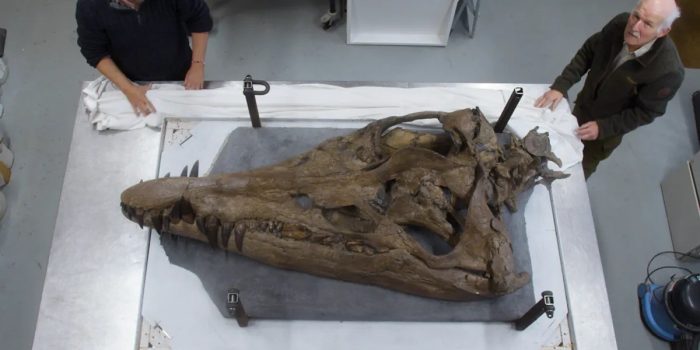In 2023, the scientific community was left awestruck by the unearthing of a 150-million-year-old pliosaur skull, affectionately christened “SeaRex,” along the Jurassic Coast. This ancient denizen of the seas, celebrated for its bite force potentially surpassing even the mighty Tyrannosaurus rex, quickly garnered widespread acclaim upon its extraction from a cliffside soaring 12 meters (39 feet) above ground level.
Boasting an astounding 95 percent completeness by surface area, the SeaRex skull reigns as the most impeccably preserved specimen of its kind worldwide, adorned with an impressive array of 130 intricately interlocked teeth.
“I have studied many Kimmeridgian pliosaurs but have never seen one that is quite so well preserved as [this],” pliosaur expert Dr Judyth Sassoon from the University of Bristol told Guinness World Records. “It contains a lot of anatomical details in a single specimen that are only found partially preserved in other specimens.”
Dr. Judyth Sassoon lauded the find for its unprecedented anatomical detail, surpassing the partial preservation typically observed in other specimens of its kind. The remarkable discovery unfolded when fossil enthusiast Phil Jacobs stumbled upon a snout on a Dorset beach, subsequently alerting fossil expert Steve Etches MBE. Etches, curator of the Etches Collection, embarked on an arduous journey to secure the remaining parts of the skull, which were found protruding from the cliffside.
“We put a drone up and scanned all the way along the cliff, and then found what looked to be the rest of it stuck out. We needed to confirm that, so that meant a trip down the cliff on ropes to actually go down and see it. From there, we realised that it was preserved upside and that was the reason it looked so weird,” Etches told IFLScience.
“It didn’t take very long to actually locate where the thing was, but it was right in the middle of a cliff. And you think, ‘Oh God.’ You look on these programs and they’re in a quarry and it’s dead easy, and they have their cups of tea and they brush away – this was nothing like that, I can tell you.”
The extraction process, chronicled in the BBC program “Attenborough And The Giant Sea Monster,” proved to be a test of endurance, underscoring the sheer magnitude of the find. Even esteemed naturalist Sir David Attenborough expressed astonishment at the skull’s colossal size, emphasizing its unparalleled informative and delicate nature.
“That is one of the biggest skulls you’ve ever seen,” Sir David Attenborough said in a release emailed to IFLScience. “I mean, it’s huge and so although I was aware of the tip that was first discovered I hadn’t fully appreciated how big the whole head would be and it’s enormous. Sheer scale was what first impressed me.”
“The thing about the skull is that it’s not only by far the most informative part of the body, it is by far the most delicate too,” he added. And it’s the detail, and that is so rare to find it. [T]his is as near-perfect as it can possibly get.”

The SeaRex skull now proudly adorns the halls of the Etches Collection in Kimmeridge, Dorset, hailed by Etches as a pivotal specimen of global significance. However, the collection’s endeavors don’t stop there, as they seek to unravel more secrets hidden within the Kimmeridge clay. Fossil expert Chris Moore remains optimistic about the potential discovery of the pliosaur’s remaining body parts, alluding to evidence of additional bones within the excavation site.
“The rest of the body is there, I’m sure,” fossil expert Chris Moore told IFLScience. “It’s slightly disarticulated, so it’s come apart, but it’s all there.”
“We took out part of the shoulder blade, some paddle digits and some of the vertebrae, that were inside of the head and you could see there were more bones going in. So, I’m sure the whole animal is there.”
As the Etches Collection rallies for support to “Rescue the SeaRex,” anticipation mounts for further revelations along the Jurassic Coast. The unearthing of this prehistoric giant not only enriches our understanding of ancient marine ecosystems but also serves as a testament to the enduring allure of paleontological exploration. With each fossil fragment meticulously unearthed, humanity inches closer to unraveling the mysteries of our planet’s distant past.


